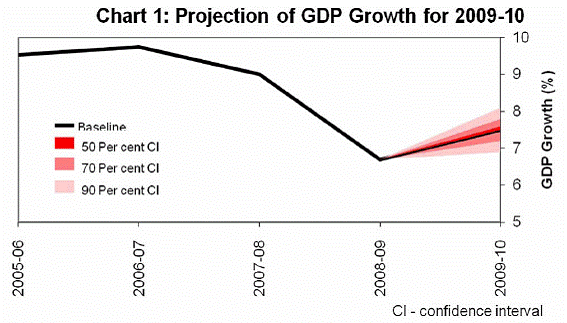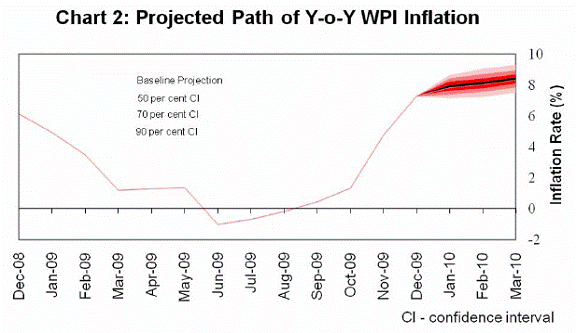India Monetary Policy Tightens, Read Hawkish and Inflation to Rise
Interest-Rates / India Jan 29, 2010 - 03:26 AM GMTBy: Vishal_Damor
 Our view for the last six months has been that while US will face deflation over the next decade, India and China will be left to battle with hyper inflation which is now slowly getting out of hand.
Our view for the last six months has been that while US will face deflation over the next decade, India and China will be left to battle with hyper inflation which is now slowly getting out of hand.
Inflation began with a supply crunch of essential food commodities and now may just begin to spill over into other parts of the economy. RBI is extremely wary and hawkish concerning Inflation and today policy decision has almost made it certain that India is becoming hawkish in the short and medium term. Bond yields have also started to price in rate hike.
Implications from market viewpoint: Only CRR hike is in line with the market expectation but 75bps magnitude was chosen to clearly indicate what is at the top of the RBI’s mind now. The document talks about growth being uneven and the recovery not fully there, but apart from the possibly mandatory mentions, the focus is almost exclusively on why tightening is needed. Many of the statements corroborate the points made by us in recent past on unsustainability of borrowing program, not enough liquidity for both the government and recovering private sector, the RBI’s inability to support in FY11 the way it did in FY10, demand side inflation pressure etc etc. Overall, the document marks the beginning of a tightening policy cycle but more importantly a start of likely change in main economic objectives in various arms of policy-making. This is unlikely to be received positively by the market near-term.
Some interesting things from the RBI’s document:
12. We will have to await the forthcoming budget in end-February 2010 for the Government’s decision on phasing out the transitory components of the stimulus. As regards the structural components, even though they were one-off, some of their impact is expected to continue over the next couple of years, as state governments and public sector enterprises align their compensation structures with the recommendations of the Sixth Pay Commission.
Our view: Budget will have a few surprises maybe on the negative side.
13. Managing the government borrowing programme to finance the large fiscal deficit posed a major challenge for the Reserve Bank. In order to address this, the Reserve Bank front-loaded the government borrowing programme, unwound MSS securities and undertook OMO purchases.
Our view: they won’t be able to do the same to help out government in current year if government has high borrowing program.
21. In the Second Quarter Review of October 2009, we had placed the baseline projection for GDP growth for 2009-10 at 6.0 per cent with an upside bias. The movements in the latest indicators of real sector activity indicate that the upside bias has materialised. Assuming a near zero growth in agricultural production and continued recovery in industrial production and services sector activity, the baseline projection for GDP growth for 2009-10 is now raised to 7.5 per cent.

Our view: RBI has confidence in the Industrial recovery but continues to maintain a subdued view on Agri on account of the eractic monsoon. We believe RBI may be in for surprise as crops yields go up and Agri bounces back.
25. Assessment of inflationary pressures has become increasingly complex in the recent period as the WPI and CPI inflation rates have shown significant divergence. All the four CPIs have remained elevated since March 2008 due to the sharp increase in essential commodity prices.

Our view: This is our view.
26. The Second Quarter Review of October 2009 projected WPI inflation of 6.5 per cent with an upside bias for end-March 2010. The upside risks in terms of higher food prices reflecting poor monsoon have clearly materialised. However, some additional factors have also exerted upward pressure on WPI inflation. One, the expected seasonal moderation has not taken place, other than in vegetables. Two, prices of the non-administered component of the fuel group, tracking the movement in global crude prices, have also risen significantly. Three, there have also been some signs of demand side pressures. The Reserve Bank’s quarterly inflation expectations survey for households indicates that inflation expectations are on the rise. Keeping in view the global trend in commodity prices and the domestic demand-supply balance, the baseline projection for WPI inflation for end-March 2010 is now raised to 8.5 per cent.
Our view: Precisely our points but the highlighted part is the first admission we have seen of “demand side pressure”.
32. Beyond the above risk factors, by far a bigger risk to both short-term economic management and to medium-term economic prospects emanates from the large fiscal deficit. The counter-cyclical public finance measures taken by the government as part of the crisis management were necessary; indeed they were critical to maintaining demand when other drivers of demand had weakened. But as the recovery gains momentum, it is important that there is co-ordination in the fiscal and monetary exits. The reversal of monetary accommodation cannot be effective unless there is also a roll back of government borrowing. As indicated earlier even as the government borrowing had increased abruptly during 2008-09 and 2009-10, it could be managed through a host of measures that bolstered liquidity. Those liquidity infusion options will not be available to the same extent next year. On top of that, there will be additional constraints. Inflation pressures will remain and private credit demand will be stronger with the threat of crowding out becoming quite real.
Our view: This is extremely conducive for India economic standing vis vis other developed markets. Fiscal tightening that few expect could be around the corner if this is heeded by the government. This is a very strong message from the RBI. Assuming that it is also accepted by the Finance Ministry, it augurs badly for taxes near-term and very well for economic stability medium-term. Moodys will be extremely happy as they may want to review India Rupee standing.
(i) A consolidating recovery should encourage us to clearly and explicitly shift our stance from ‘managing the crisis’ to ‘managing the recovery’. We articulated this change in our stance in the October quarterly review, but the growing confidence in the recovery justifies our moving further in reversing the crisis-driven expansionary stance. Our main policy instruments are all currently at levels that are more consistent with a crisis situation than with a fast-recovering economy. It is, therefore, necessary to carry forward the process of exit further.
Our view: Hawkish.
Market had expected a hawkish RBI policy but I think RBI has surprised everyone with their actions and the wording of their statement.
We maintain that this is extremely bullish signal for Indian economy over the longer term as rate rises and CRR hikes should be seen in light of macro picture of growth.
The full PDF is attached below. It is quite interesting to note how central banks review economy.
TQRAPJAN2010
Vishal Damor
http://investingcontrarian.com/
Vishal Damor, works for an emerging market financial consulting firm and is the editor at INVESTING CONTRARIAN, a financial analysis and reporting site covering commodities, emerging markets and currencies.
© 2010 Copyright Vishal Damor - All Rights Reserved
Disclaimer: The above is a matter of opinion provided for general information purposes only and is not intended as investment advice. Information and analysis above are derived from sources and utilising methods believed to be reliable, but we cannot accept responsibility for any losses you may incur as a result of this analysis. Individuals should consult with their personal financial advisors.
© 2005-2022 http://www.MarketOracle.co.uk - The Market Oracle is a FREE Daily Financial Markets Analysis & Forecasting online publication.



